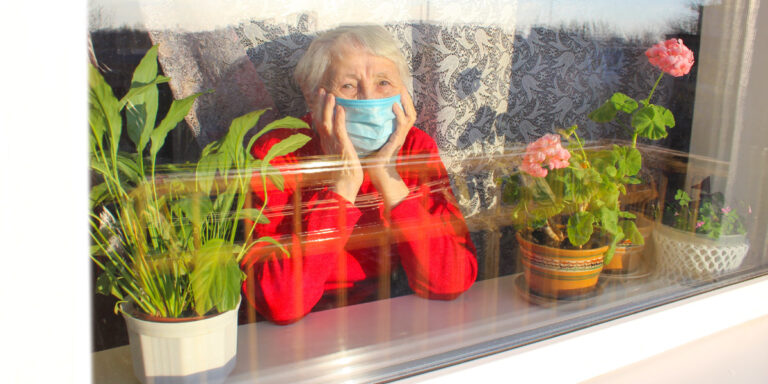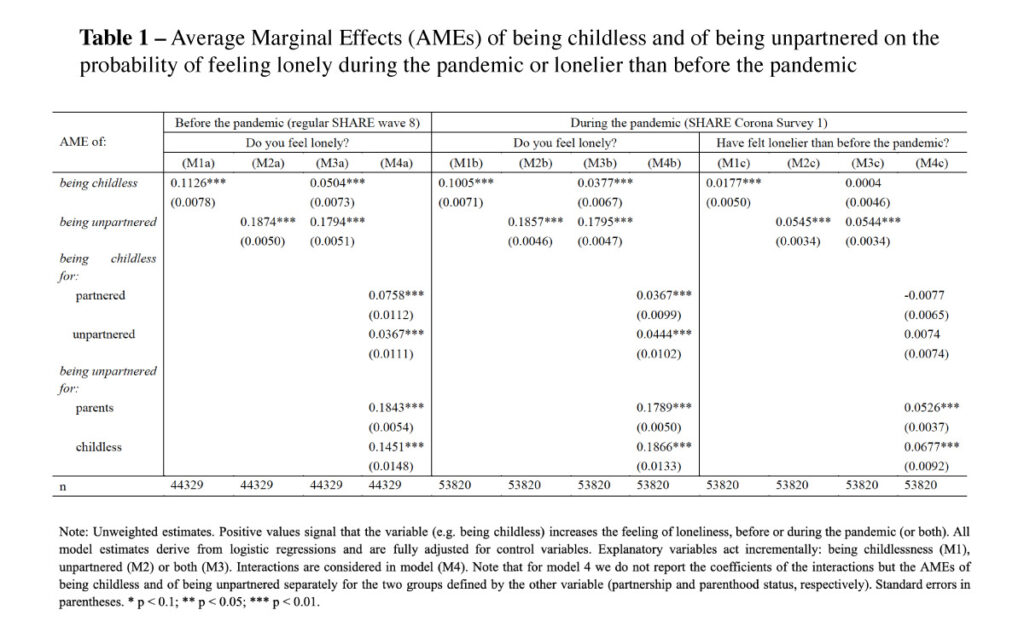Kinlessness and loneliness before and during the COVID-19 Pandemic

The pre-COVID literature established that lacking a partner or children was among the risk factors for loneliness among older people. Bruno Arpino, Christine A. Mair, Nekehia T. Quashie, and Radoslaw Antczak examine the associations of loneliness with partnership and parenthood and whether they changed with the COVID-19 pandemic.
Research prior to the COVID-19 outbreak identified being unpartnered or childless as risk factors for loneliness among older adults (Dahlberg et al. 2022; Fokkema et al. 2012). The COVID-19 pandemic might have affected loneliness among kinless older adults differently from the rest of the older population. With the aim of fighting the spread of the virus, several mitigation policies and recommendations were implemented at national, regional, and local levels. These mitigation strategies, which were especially stringent during the first phases of the pandemic and varied across countries, included avoidance of public social spaces, minimizing physical contact with others, “stay-at-home” orders, and full physical isolation, especially for older adults, and those with health issues in particular.
Kinlessness, loneliness and the COVID-19 pandemic
The “physical distancing” imposed by these strategies also produced “social distancing”, i.e. reduced social contacts, at least face-to-face (Arpino et al. 2021). Thus, anti-COVID policies may have exacerbated risks of loneliness, among older adults especially (Dahlberg 2021; van Tilburg et al. 2021). These consequences may have been more serious for those lacking close kin, such as unpartnered or childless older adults. For example, the types of contacts that are more common in networks of kinless older adults, such as extended family and non-family ties, may have been more vulnerable to disruption during the pandemic compared to partner and child ties.
On the other hand, linkages between parenthood, partnership, and loneliness are complex and may have been particularly nuanced during the pandemic. For example, older parents who are accustomed to frequent in-person contact with their children may have experienced an uptick in loneliness when child contact was disrupted. Childless older adults, on the other hand, might be more accustomed to less contact and may therefore have experienced less disruption.
Loneliness before and during the pandemic in Europe
In a recent study (Arpino et al. 2022), we examined whether unpartnered and childless older adults (aged 50 years and over) were more likely to report loneliness compared to those with these family ties, and whether the gap in loneliness between those with and without these ties increased during the COVID-19 pandemic. Our analyses are based on data from the Survey of Health, Ageing and Retirement in Europe (SHARE). We used pre-COVID data from wave 8, which started in October 2019 but was suspended in all countries in March 2020 due to the COVID-19 outbreak. We also used data from the SHARE Corona Survey 1 (SCS1) implemented between June and August 2020 to collect information on individuals’ behaviours and conditions during the pandemic.
Our analyses show that before the pandemic, when asked “Have you felt lonely recently?”, unpartnered and childless older adults were more likely to report loneliness compared to those with these family ties (Table 1, M1a-M2a). This remained true even when both factors were considered together, although the effect of childlessness on loneliness was smaller (Table 1, M3a). Older adults lacking one tie only (unpartnered parents or partnered childless) were at greater risk of loneliness compared to those who had both ties (Table 1, M4a).
During the pandemic, the associations between family ties and loneliness remained stable, with no notable change in the effects of being childless or unpartnered on loneliness before versus during the pandemic (Table 1, M1b-M3b). However, in contrast to the pre-COVID period, considering the combination of being childless and unpartnered made no difference (Table 1, M4b): In fact, in this case, the average marginal effect (AME) of parenthood is very similar for partnered and unpartnered individuals; similarly, the AME of partnership does not change significantly by parenthood. As a result, the effects of being unpartnered and childless on loneliness became more independent during the pandemic.

Feeling more lonely during the pandemic
Our second outcome examines whether people reported feeling more lonely during the pandemic. We found that unpartnered individuals were more likely to report feeling lonelier during the COVID-19 pandemic compared to those in a partnership. Childless individuals, on the other hand, were not at higher risk of reporting feeling lonelier compared to parents (Table 1, M1c-M3c). The effect of being unpartnered was slightly stronger among childless individuals, but the difference in the impact of being unpartnered on loneliness between childless and parent individuals was not statistically significant (Table 1, M4c).
Changes and stability in feeling lonely compared to before the pandemic
Our third outcome was obtained by combining the answers to the question “Have you felt lonely recently?” asked of respondents who participated in both the regular SHARE wave 8 and the SCS1. This analysis (not presented in Table 1) highlights that unpartnered individuals were more likely to “have become lonely” during the pandemic, while childless and unpartnered individuals were less likely to “exit” loneliness if they felt lonely before the pandemic.
Conclusions
We found that both before and during the pandemic, lacking close kin (especially a partner) was associated with a higher risk of feeling lonely among older Europeans. However, “kinless” older adults (unpartnered and childless) were not lonelier than those who lacked only one of these ties. This may signal that kinless individuals have developed a range of resources and different coping strategies to manage the lack of close kinship ties, such as a rich network of friends (Mair, 2019).
While “physical distancing,” “lockdown,” and “stay-at-home” mitigation measures provided protection from COVID-19, the restrictions on face-to-face interactions and public spaces for socializing also removed key sources of social integration for those who were already more likely to spend time alone (e.g., the unpartnered). As the population of unpartnered and childless older adults grows globally, future public health strategies should seek a balanced mitigation approach that also considers the consequences of isolation, particularly for those who are already at higher risk for loneliness.
References
Arpino, B., Pasqualini, M., and Bordone, V. (2021) Physically distant but socially close? Changes in non-physical intergenerational contacts at the onset of the COVID-19 pandemic among older people in France, Italy and Spain. European Journal of Ageing, 18, 185–194.
Arpino B., Mair C. Quashie N., and Antczak R. (2022) Loneliness Before and During the COVID-19 Pandemic: Are Unpartnered and Childless Older Adults at Higher Risk? European Journal of Ageing. 19, 1327–1338.
Dahlberg L (2021) Loneliness during the COVID-19 pandemic. Aging & Mental Health, 25(7): 1161–1164.
Dahlberg L, McKee KJ, Frank A, Naseer M (2022) A systematic review of longitudinal risk factors for loneliness in older adults. Aging & Mental Health, 26(2): 225–249.
Fokkema, T., De Jong Gierveld, J., & Dykstra, P.A. (2012). Cross-national differences in older adult loneliness. The Journal of Psychology, 146(1-2), 201-228.
Mair, Christine A. (2019). “Alternatives to Aging Alone?: ‘Kinlessness’ and the Importance of Friends across European Contexts.” Journal of Gerontology: Social Sciences 74(8):1416-1428.
Van Tilburg, T.G., Steinmetz, S., Stolte, E., van der Roest, H., & de Vries, D.H. (2020). Loneliness and Mental Health During the COVID-19 Pandemic: A Study Among Dutch Older Adults. Journal of Gerontology: Social Sciences, 76(7), e249-e255